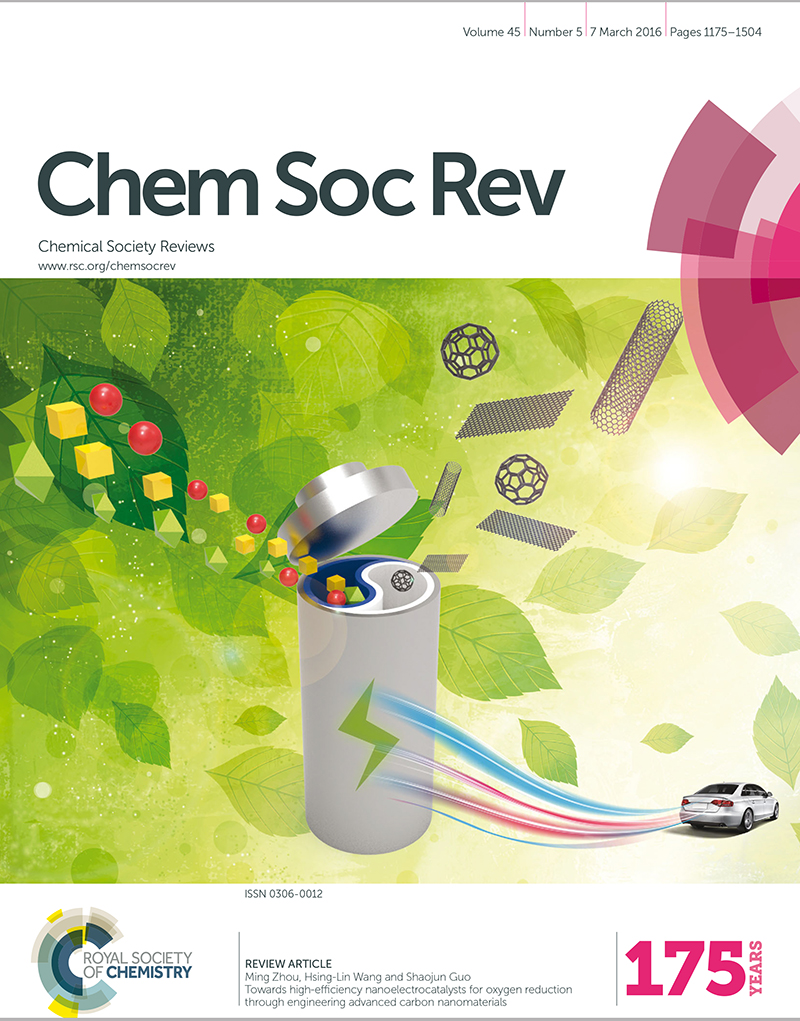High-efficiency nanoelectrocatalysts
A publication highlights recent advances
Efficient catalysts made from abundant materials enable industrial development of energy-related technologies
Chemistry Division Scientist Hsing-Lin Wang (C-PCS) along collaborators Ming Zhou (Northeast Normal University, Changchun, China) and Shaojun Guo (Peking University, Bejing, China) recently published a review article on nanoelectrocatalysts that captured the cover of the journal Chemical Society Reviews. Development of new, more efficient catalysts made from abundant materials is a key element in enabling industrial development of many energy-related technologies.
Industrial fuel cells such as proton exchange membrane fuel cells, direct methanol fuel cells, and biofuel cells suffer from high cost, serious intermediate tolerance, anode crossover, sluggish kinetics, and poor stability of the catalyst. These fuel cells generally use precious metal such as platinum (Pt) as the preferred electrocatalysts for the oxygen reduction reaction (ORR) at the cathode. The search for inexpensive electrocatalysts free from noble metals and practical for ORR has created one of the most active and competitive fields in chemistry and materials science.
Fuel cells are clean and efficient energy conversion devices that can directly convert the chemical energy of fuels to electricity through electrochemical processes. By using hydrogen (H2) or methanol as fuels and oxygen (O2) as reductants, fuel cells can be operated at close to room temperature, and are considered as promising power solutions for future electric vehicles and portable electronic devices. However, the cost of platinum accounts for up to 49% of fuel cell stack cost. Therefore, the cost of fuel cells is directly linked to the price of platinum in the volatile and highly monopolized precious metal market. In recent years, Wang’s lab has developed highly efficient nonprecious metal electrocatalysts for ORR, hydrogen evolution reaction (HER) and oxygen evolution reaction (OER).
In the review article, Wang and colleagues summarize recent advances in engineering advanced carbon nanomaterials with different dimensions for the design and synthesis of noble-metal-free oxygen reduction electrocatalysts, including heteroatom-doped carbon nanomaterials, transition metal-based nanoparticle (NP)–carbon nanomaterial composites and especially the stable iron carbide (Fe3C)-based NP–carbon nanomaterial composites. They also examine advanced carbon nanomaterials with high specific surface area and stable structure. These ORR materials do not use noble metals and maximize electrocatalyst surface area for the electron transfer while enhancing electrocatalyst stability for long-term operation. They discuss examples that will open up new directions for designing and optimizing advanced carbon nanomaterials for the development of extremely active and durable earth-abundant cathodic catalysts for fuel cell applications.Ref: Chem. Soc. Rev., 2016, 45, 1273 DOI: 10.1039/c5cs00414d

Funding: LDRD
Technical contact: Hsing-Lin Wang





